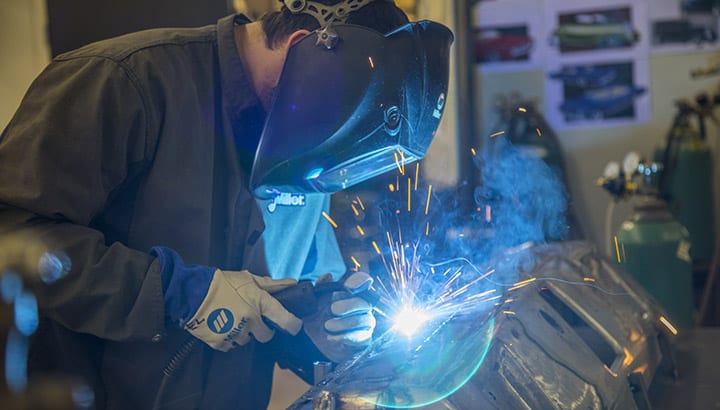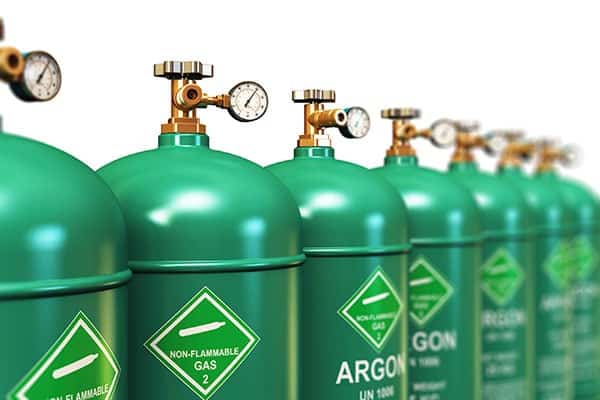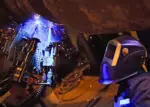Wire feed welder produces a lot of spatter and therefore you need to be very careful about the selection of the shielding gas to be used.
 The wrong shielding gas will only react with the materials and produce lot more spatter unnecessarily! Whereas the right shielding gas will reduce it to a great extent!
The wrong shielding gas will only react with the materials and produce lot more spatter unnecessarily! Whereas the right shielding gas will reduce it to a great extent!
And if you ask me about the best shielding gas to be used in wire feed welder, I would definitely recommend using the inert gas argon!
The reason why argon is used in a wire feed welder as the shielding gas because it is the least reactive gas with any material and hence it decreases the chances of spatters in the weld while also increasing the fluidity of the weld pool and the penetration power!
But argon is not the only gas that can be used in the wire feed welder, there are other gases as well which can be substituted for pure argon and in this article, I am going to tell you about all of them and also why argon is the best option when it comes to wire feed welder!
But first let us learn what a wire feed welder is and how does it work…
What is a wire feed welder and how does it work?
A wire feed welder is perhaps the easiest way to weld metals. It uses a wire feed that is placed inside the machine gun. You just need to press the trigger of the gun and immediately a fresh strand of wire will extend out of the tip of the gun.
This particular wire is electrically energized and therefore, it produces a blue arc from the tip of the wire. This arc melts the protruded wire as well as the metal to be welded. You just need to move the gun along the seam that you are joining and the deposition of the wire feed continuous until you get the desired weld!
But there is a problem with this process of welding and that is it produces a lot of sputtering because of the presence of debris! And in order to avoid this problem, you need to select the correct shielding gas!
What kind of gas does a wire feed welder use?
Perhaps the most common type of shielding gas used in a wire feed welder is the pure argon!
The advantage of using argon as a shielding gas for wire feed welding over other gases is that argon increases the penetration level, improves precision, provides arc stability and decreases splatter!

But there are also other gases that can be used instead of argon in a wire feed welder and they are CO2, Oxygen, Helium and a mixture of helium and argon. I will be discussing about the usage of all these gases in section below in this article
Pros and cons of using argon gas in wire feed welder
Argon is a lazy and inactive gas, but still there are some pros and cons to using argon as a shielding gas in welding and they are:
Pros of using argon as a shielding gas:
-
-
- As I have mentioned, argon is a noble gas and therefore, it does not react with other gases when used in welding
- Argon is non-flammable and therefore it does not support combustion. Therefore, it is safe for welders in welding processes producing heat as much as 7000 degrees F.
- Argon is abundant in the earth’s atmosphere and therefore available at a low cost
- It also helps to protect the integrity of the weld
- The best part with argon is that it provides arc stability and greater precision
- Argon helps to disperse any contaminating elements present in the atmosphere while welding and therefore, protects the weld from corrosion and oxidation
- It produces cleaner and stronger welds as it reduces spatters
-
Cons of using argon as a shielding gas:
-
-
- The penetration level offered by argon is not that great and therefore, it is suitable only for thinner sheets of metals
- Argon also produces uneven beads in the weld which does not look that great
-
Therefore, argon is used in mixture with other gases in order to achieve the best quality weld which I will be discussing down this article!
Alternatives to argon gas in a wire feed welder
As mentioned above there are 4 alternatives to using argon as the shielding gas in a wire feed welder and they are:
1.) Helium:
Helium is perfect when you need a wide and deep penetration cavity that is necessary to weld thick metals. Helium also aids in improving the bead profile and the penetration speed.
2.) Oxygen:
Now, using oxygen is very tricky because oxygen is super reactive with metals. Therefore, a concentration of oxygen not more than 9% is used in welding. Oxygen helps to improve the fluidity of the weld pool, and increases penetration and arc stability.
But the problem with oxygen is that it oxidizes metals therefore, you cannot use oxygen withy metals that are prone to oxidation.
3.) Carbon Dioxide:
Carbon Dioxide is in fact, the most common gases that is used in a wire feed welding and can be used in its purest form. Co2 provides the best penetration for thicker metals.
But the problem with Co2 is that it produces more spatter and provides a less stable arc. Therefore, Co2 cannot be used alone and has to be used in mixture with other gases like argon for effective results.
4.) Combined gases:
For the best and effective results, combination of gases is used in wire feed welder and they are:
-
-
- 75 to 90% argon with pure carbon dioxide or 5 to 10% CO2
-
-
-
- 25 to 75% helium with 75 to 25% argon
-
-
-
- 95 to 99% argon with 1 to 5% oxygen
-
-
-
- 90% helium, 7.5% argon and 2.5% CO2
-
-
-
- 33% helium, 66.1% argon and 0.9% CO2
-
-
-
- 26.5% helium, 66% argon and 7.5% CO2
-
Let’s call it a Day!
While Carbon Dioxide is the cheapest gas available, it produces a lot of spatters and does not provide arc stability, oxygen causes oxidation in some metals and helium is not that effective for thinner metals. Therefore, the best choice of shielding gas is perhaps argon when it comes to wire feed welding like MIG welding!
That said, we have come to the end of this article!
Stay tuned to the site for more exciting articles on welding!
Till then…
Have a happy and safe welding!







